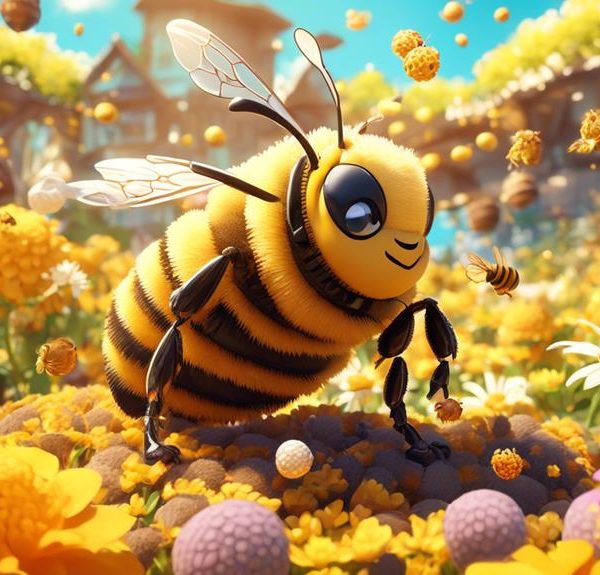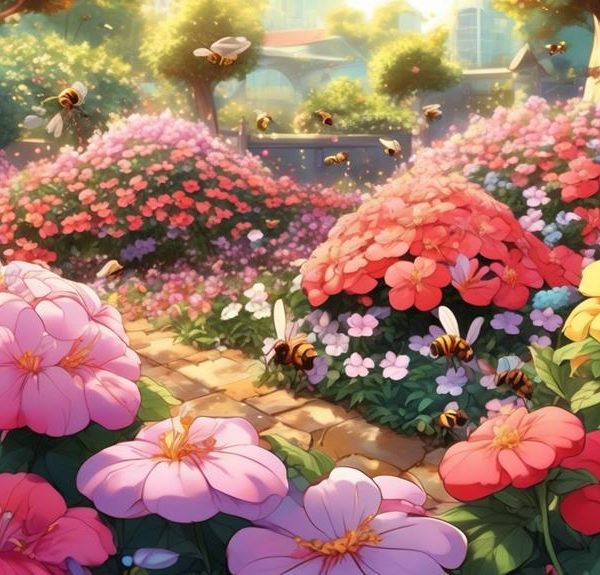Investigate the intriguing relationship between bees and foxgloves, and uncover the mystery behind their buzzing attraction in your garden.
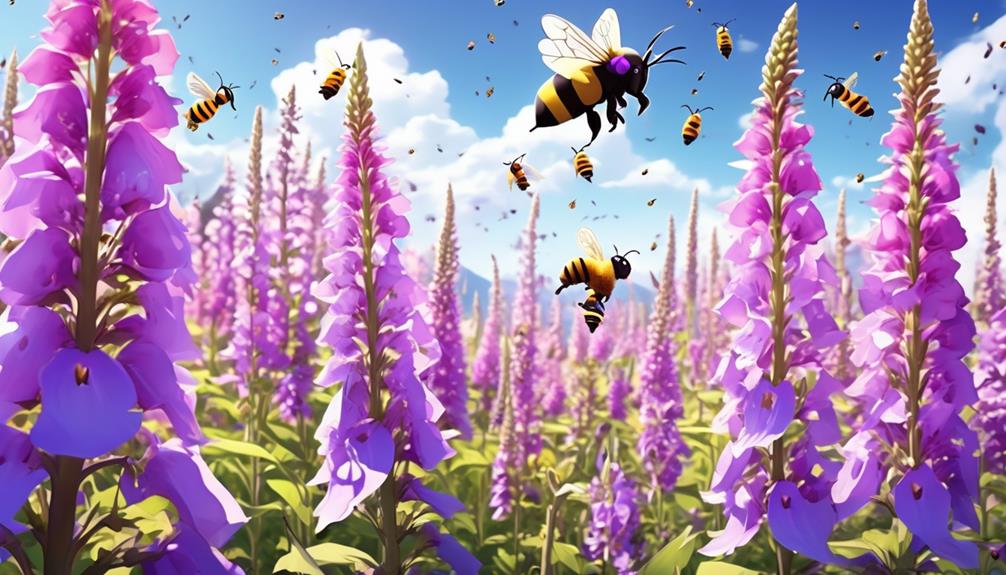
Do Bees Like Foxgloves?
Imagine this: you're sitting in your garden on a serene summer afternoon, and you notice a bustling scene around your foxglove flowers. Bees are swarming, darting in and out of the tall, bell-shaped blooms. They're busy, aren't they?
But do the bees actually like these foxgloves, or is there something else that's drawing them in? That's a question that's sparked quite a bit of conversation among gardeners and bee enthusiasts alike.
So, let's explore the relationship between bees and foxgloves, and maybe we'll discover if your garden is a bee paradise or just a convenient pit stop.
Key Takeaways
- Bees are attracted to the shape, colors, and patterns of foxgloves.
- Foxgloves provide a rich source of nectar and pollen for bees, benefiting their nutrition and hive sustenance.
- The unique characteristics of foxgloves, such as their tubular shape and downward tilt, are perfectly designed for bees' feeding and pollination.
- The presence of foxgloves in a garden promotes biodiversity, aids in pollination, and attracts other beneficial species like birds for pest control.
The Intriguing World of Bees
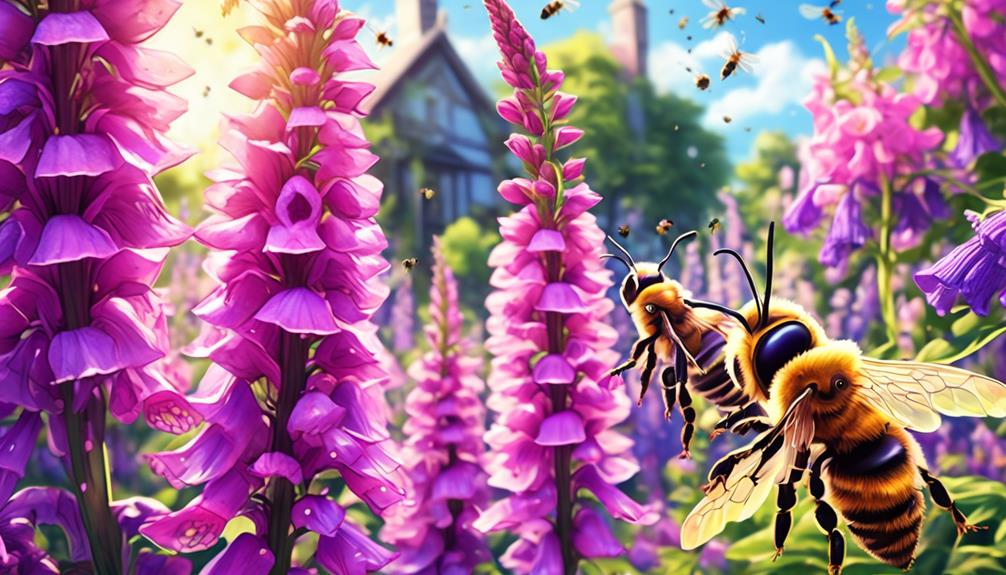
Delving into the intriguing world of bees, you'll find these industrious insects have complex behaviors and interactions with various flora, including the captivating foxgloves. Their ability to communicate with their hive through a unique 'waggle dance' is a marvel of nature, signaling the direction and distance to nectar-rich flowers.
Bees have a fondness for foxgloves' bright, bell-shaped flowers. Why's that? It's because the shape and structure of foxgloves make it an ideal feeding spot for bees. The long, tubular flowers serve as a perfect landing pad, and their speckled interiors act as a navigational guide, leading bees to the nectar at the base. This is a prime example of co-evolution, where both species benefit.
Further, bees' color vision is most sensitive to blue and green, and less so to red hues. But foxgloves, despite their vibrant pinks and purples, emit ultraviolet patterns invisible to human eyes but not to bees. These patterns act like a bullseye, directing bees to the flower's nectar source.
Understanding Foxglove Flowers
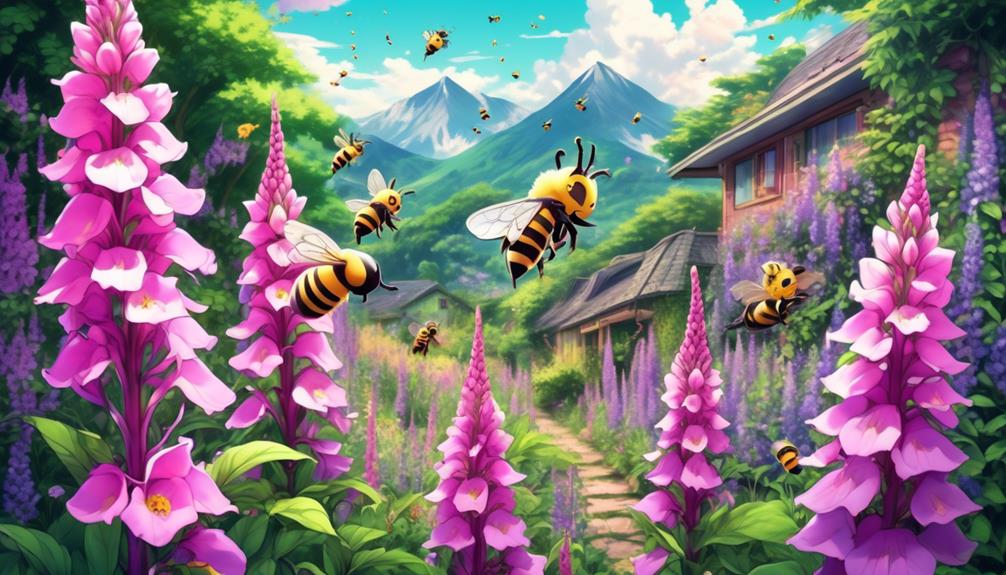
Often overlooked, foxglove flowers are a fascinating study in botanical brilliance, offering not just aesthetic appeal but also a unique adaptation that facilitates their survival and propagation. You'll be captivated by their unique bell-shaped blooms that hang downwards in an array of vivid colors from deep purples to soft pinks and creamy whites.
Not just a feast for the eyes, these flowers are designed for efficiency. They've evolved a clever mechanism to attract pollinators like bees, making them an important part of the ecosystem. The lower lip of the flower forms a convenient landing platform for bees, and the bell shape guides them straight into the heart of the flower.
Here's a quick table to give you a snapshot of their unique characteristics:
Unique Feature | Role |
|---|---|
Bell-shaped bloom | Guides pollinators into the flower |
Vivid colors | Attracts bees and other pollinators |
Lower lip platform | Allows easy access for pollinators |
Bee and Foxglove Interaction
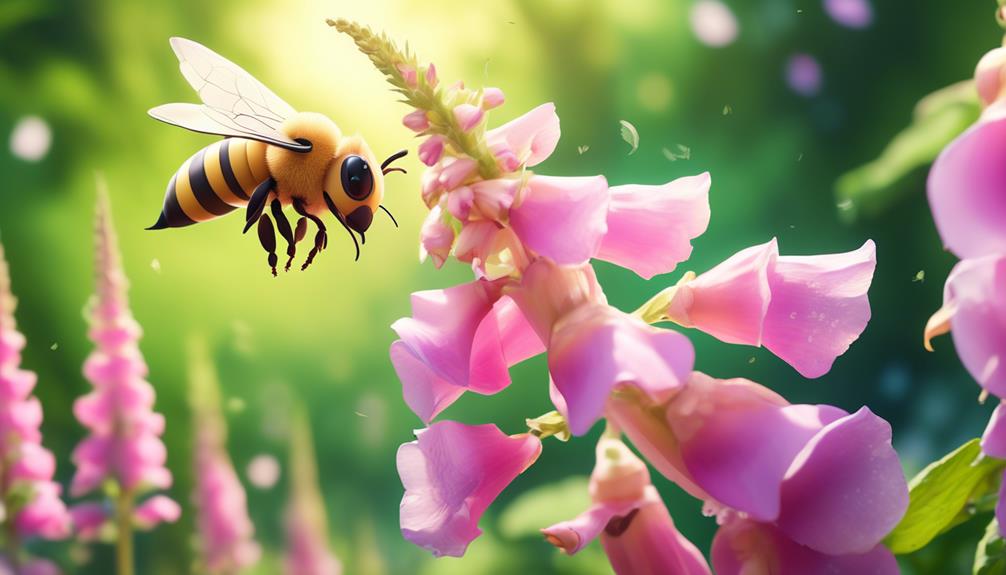
When you observe a bee buzzing around a foxglove flower, you're witnessing a complex interaction that plays a crucial role in the survival and propagation of both species. Bees are attracted to the bright colors and distinctive patterns of the foxglove, which signal a rich nectar source. The flower's tubular shape and downward tilt are perfectly designed for the bee's body shape and flight pattern.
As a bee lands on a foxglove's lower petal, it steps onto a sort of natural springboard. This propels the bee upwards and into the flower's bell, where pollen is then deposited on the bee's body. In this way, the foxglove ensures its pollen is carried to other flowers, assisting in cross-pollination.
But it's not a one-way street. The bee, dusted with pollen, flies off to another foxglove. Here, it collects more nectar while simultaneously depositing the previously gathered pollen. This pollination process is vital for the foxglove's reproduction, and the bee benefits by collecting nectar for its hive.
Benefits of Foxgloves for Bees
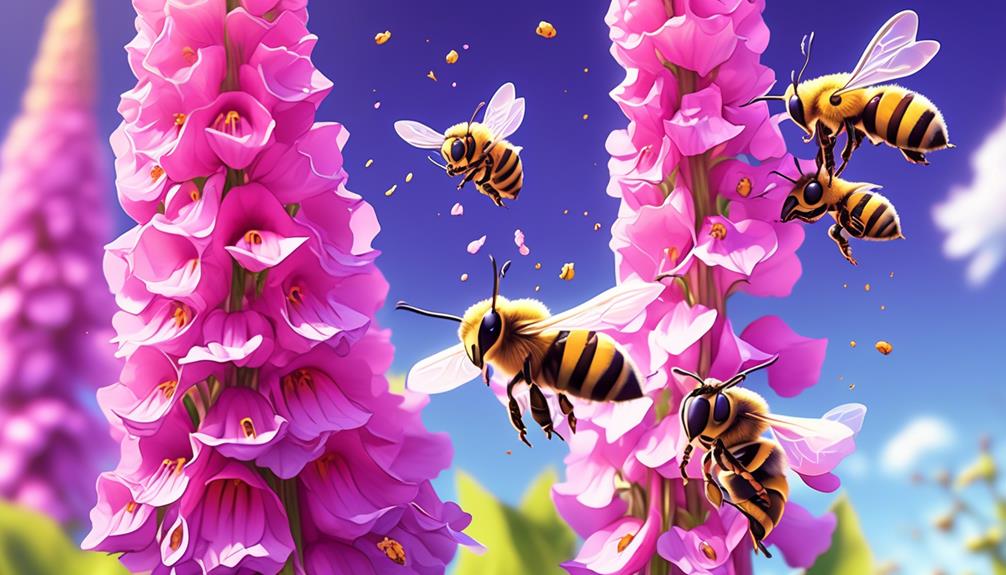
In understanding the symbiotic relationship between bees and foxgloves, it's crucial to highlight the numerous benefits that bees derive from these vibrant flowers. Not only do they act as a rich nectar source, but they also provide abundant pollen, essential for bee nutrition and hive sustenance.
Foxgloves, with their tall spikes of tubular flowers, are perfectly shaped for the bees' body, allowing them to crawl inside and gather nectar effectively. As they do so, they unintentionally collect pollen on their bodies, which they later distribute to other flowers, aiding in pollination. This symbiosis ensures the survival of both the bees and the foxgloves.
Moreover, the foxglove's speckled interior serves as a landing guide for the bees, directing them towards the nectar source. This, in turn, improves the bees' foraging efficiency. Foxgloves also bloom in early summer, a time when many bee species are most active, providing a reliable food source when it's most needed.
Impact on Garden Ecosystem
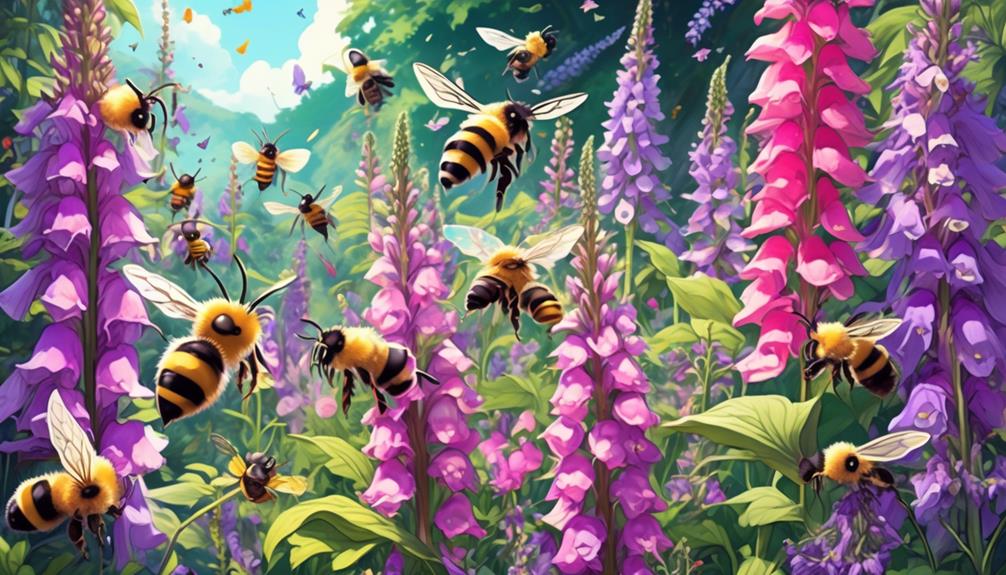
Building on the understanding of how bees interact with foxgloves, let's consider how this relationship impacts the broader garden ecosystem. Foxgloves aren't just pretty faces in your garden; they're crucial cogs in the ecological machine.
Firstly, foxgloves play a key role in pollination. Bees, attracted by their color and nectar, transfer pollen between plants, aiding in the proliferation of both the foxglove and other plant species. This promotes biodiversity and ensures the survival of various plant species in your garden.
Secondly, the presence of bees, drawn by foxgloves, benefits the entire food chain in your garden. Many birds feed on bees, so a bee-rich garden often attracts a broader range of bird species. This not only adds aesthetic value but also helps with pest control, as many bird species feed on common garden pests.
Lastly, foxgloves are known for their 'self-seeding' ability. This means they drop seeds that grow into new plants, reducing soil erosion and maintaining soil quality.
Frequently Asked Questions
What Other Flowers Do Bees Prefer Apart From Foxgloves?
You're curious about what other flowers bees prefer, aren't you?
Well, besides foxgloves, bees are particularly drawn to plants like lavender, clover, and sunflowers. They can't resist the bright colors and sweet nectar of these blooms. Coneflowers and black-eyed Susans also make the list.
It's fascinating how these tiny creatures have such diverse tastes, isn't it?
How Can I Attract More Bees to My Garden?
You can attract more bees to your garden by planting a variety of native, flowering plants. Bees favor blossoms that are blue, purple, and yellow. Ensure continuous bloom throughout the growing season and provide a fresh water source.
Avoid using pesticides. Create nesting sites by leaving some ground undisturbed and providing hollow twigs or bamboo tubes.
Are There Any Potential Dangers for Bees When They Interact With Foxgloves?
Yes, there are potential dangers for bees interacting with foxgloves. Foxgloves produce a toxin called digitalis, which can be harmful to bees if ingested in large quantities. However, bees are typically quite savvy and avoid plants harmful to them.
It's more of a danger if the pollen or nectar is brought back to the hive and fed to the larvae. But don't worry, your bees are likely smart enough to stay safe!
Do Foxgloves Have Any Effect on the Quality or Taste of the Honey Produced by Bees?
Yes, foxgloves can impact the taste of honey. When bees collect nectar from different flowers, it affects the honey's flavor.
Foxglove's nectar might give the honey a unique, slightly bitter taste. However, it doesn't change the quality of the honey. Bees are great at turning nectar into delicious, nutrient-rich honey, regardless of the flower source.
It's fascinating, isn't it? Nature's little workers ensuring we get varied flavors of honey!
What Other Insects Are Attracted to Foxgloves Aside From Bees?
You're curious about what other insects are drawn to foxgloves besides bees.
Well, foxgloves are a magnet for a variety of insects, not just bees.
Butterflies, especially the Brimstone and Peacock varieties, find foxgloves irresistible.
Hummingbird moths too are often seen hovering around these plants.
Even some types of beetles can't resist their charm.
Conclusion
In conclusion, you'll find that bees indeed adore foxgloves. They're drawn to its vibrant hues and nectar-rich blooms.
These flowers not only offer a nutritional feast for bees but also a safe haven for laying eggs.
By planting foxgloves in your garden, you're boosting the ecosystem and aiding in the survival of these crucial pollinators.
Remember, a garden buzzing with bees is a sign of a healthy, thriving environment.

